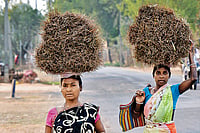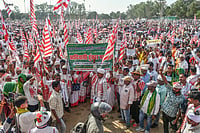In many states, including Jharkhand, land titles have not been granted in accordance with the area claimed in applications. Jharkhand has many titleholders who complain that they have been granted rights over a much-reduced area compared to what they had mentioned in the claim.
One of them is 56-year-old Jatan Singh Kharwar, a resident of the Hurdag village in the Garu block of the Latehar district. He had filed a claim for 3.14-acre land in 2016, but he has been granted the title for just 0.1-acre (1 decimal) of land. There are 45 Adivasi families in his village who have received rights over a much smaller area than the individual FRA claims they had filed. The villagers complain that 70-90 per cent of the land claimed in their applications has been removed from the titles.
Another Adivasi village, Lanka, in the Manika block of the same district also has similar complaints. Village Pradhan (head) Mahavir Parhaiya says that in 2008, 75 families from the village had filed individual claims, but only 16 people were granted titles. Even these 16 received reduced titles. Mahavir had claimed 5 acres of land, but he received the title for just one acre.
Gladson Dungdung, an author who has written several books on forest rights, says that things are the same in the entire state. Either the entire file with the claim forms is ‘disappeared’ or the title is granted over a much smaller land area than the claim.
Dungdung’s book, Adivasis and Their Forest, cites several examples of this practice. The book mentions how claims from many villages of the Manoharpur block of the West Singhbhum district disappeared from the offices. In the Kudagara village of the Namkum block in Ranchi, 347 families of the village filed a community claim on a 700-acre land. They were asked to reduce this to 100 acres, and when the villagers resisted, the claim file was misplaced. In the same village, 36 people had filed individual claims, out of which 30 were rejected, and the remaining six were approved for reduced land parcels. These include that of Bando Munda, whose claim on 8 acres was reduced to 0.7 acres.
The groups working on FRA implementation in Jharkhand claim that the majority of land titles granted in the state were approved after reducing the area claimed by the title-holders
Organizations working on forest rights in Rajasthan, Chhattisgarh, and Maharashtra also report similar trends. Vijendra Ajnabi, the convenor of Chhattisgarh Van Adhikar Manch, said that 70-80 per cent of the title-holders in the state have had their claimed area reduced. Similarly, Mangi Lal Gujjar, a member of Rajasthan Adivasi Adhikar Manch, said that nearly all the titles being distributed in the state cut down on the claimed land parcels. More than 90 per cent of the claims have been granted after reduction, he said. The activist added that around 5,000 villages in Rajasthan included forest land. Dr Satish of the Forest Rights Network said that Maharashtra had also followed the trend of reducing land from claims.
All the organizations insist that the reduction is in violation of FRA rules.
FRA expert Mithilesh Kumar explains the rules: “There are three main committees under the FRA. Firstly, the forest rights committee is under the gram-sabha, which is constituted by the gram-sabha. This committee verifies and investigates the claim documents of the applicant. Then the committee seeks the endorsement of the claim by the gram-sabha. After the endorsement, the committee sends the claim to the sub-division level committee (SLDC). The SLDC is tasked with identifying any errors in the claim form, and if so, sending it back to the gram-sabha for rectification. The gram-sabha can rectify the error and send it to the SLDC once again. Now, the SLDC is expected to forward the claim to the district-level committee (DLC) for granting the title, without reducing the area. However, usually, the SLDC takes it upon itself to reduce the land in the claim and decide an area on which title is to be granted, before sending it to the DLC. The DLC issues the title based on this claim. This is a clear violation of the FRA.”
Independent FRA researcher Tushar Das says, “The FRA claims are either being rejected or reduced. Both responses have emerged as a threat to Adivasis and Other Traditional Forest Dwellers. In 2019, the Supreme Court ordered all states to review the rejected claims. However, this order was not followed correctly. The gram-sabhas are not being provided with any information, and lakhs of claims have been reduced without involving the sabhas. The reductions and rejections are based on objections by the forest department. The objective behind this is to prevent rights over community forest land from being transferred to the gram-sabhas. The forest department wants to target this land for the major plantation project under CAMPA (Compensatory Afforestation Fund Management and Planning Authority) being carried out in the state, even though it is the people who have rights over it under the FRA. The other reason is that land banks are being formed in all states in order to hand over land to corporate groups. In Jharkhand, a large amount of community forest lands has already been included in land banks in an irregular way.”
It is important to note here that land banks were established by the last Jharkhand government of Raghubar Das in 2016. At the time, several organizations and movements had opposed the banks and accused the government of forming them in order to hand over the community lands of Adivasis and indigenous people to corporates in an unconstitutional manner. As per reports, the government had diverted around 21 lakh acre of land to the land banks.



























